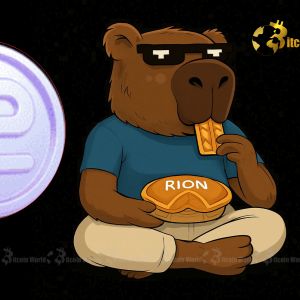Hyperion RION Tokenomics: A Crucial Unveiling for Aptos’s Decentralized Future
6 min read
BitcoinWorld Hyperion RION Tokenomics: A Crucial Unveiling for Aptos’s Decentralized Future The decentralized world is constantly evolving, bringing forth innovative projects that aim to reshape our digital interactions. One such exciting contender is Hyperion (RION), a pioneering decentralized map platform building its ambitious vision on the robust Aptos blockchain. Recently, the crypto community buzzed with anticipation as Hyperion finally pulled back the curtain, unveiling the much-anticipated RION tokenomics via a post on X. This reveal is not just about numbers; it’s a strategic blueprint outlining how the RION token will power the Hyperion ecosystem, incentivize participation, and drive its growth. Understanding these foundational elements is absolutely crucial for anyone looking to engage with this promising new frontier in decentralized mapping. What Exactly is Hyperion, and Why Does its RION Tokenomics Matter? Imagine a world where your map data isn’t owned by a single corporation, but by the community itself. That’s the bold vision of Hyperion. As a decentralized map platform, Hyperion aims to create a more open, transparent, and user-centric mapping experience, leveraging blockchain technology to achieve true data ownership and censorship resistance. In this ecosystem, the RION token serves as the lifeblood, facilitating transactions, rewarding contributors, and potentially enabling governance. The way these tokens are distributed – their RION tokenomics – dictates everything from liquidity and development funding to community engagement and long-term sustainability. It’s the very foundation upon which Hyperion plans to build its revolutionary mapping solution. Decoding the RION Token Distribution: A Strategic Blueprint The core of Hyperion’s recent announcement lies in the detailed breakdown of its token distribution . This allocation plan reveals how RION tokens will be spread across various stakeholders and functions, each serving a vital role in the platform’s journey. While an image detailing this distribution was briefly shared and then removed, the percentages provided shed significant light on Hyperion’s strategic priorities. Let’s break down each component: Allocation Category Percentage of Total Supply Purpose and Significance Liquidity Incentives 30% This substantial portion is dedicated to ensuring robust trading liquidity for RION on decentralized exchanges (DEXs). High liquidity is vital for a healthy token, allowing users to buy and sell RION efficiently without significant price slippage. It attracts traders and provides a stable market environment, signaling confidence in the token’s utility. Protocol Treasury 22.9% The treasury acts as a strategic fund for the Hyperion protocol’s long-term development, research, and ecosystem growth. It can be used for grants, partnerships, infrastructure improvements, and general operational expenses, ensuring the project’s longevity and adaptability. Team and Advisors 20% Allocated to the core team and their strategic advisors, this portion typically vests over several years. It incentivizes long-term commitment, ensuring that the builders and guiding minds behind Hyperion remain dedicated to its success and continued innovation. Public Distribution 9% This segment is for general sale or launchpad events, allowing the broader public to acquire RION tokens. It’s crucial for decentralizing ownership and bringing new users into the ecosystem, fostering wider adoption and community participation from the outset. Investors 8.1% This allocation goes to early backers and venture capitalists who provided crucial funding during the initial development stages. Their support is vital for bootstrapping the project, and this allocation serves as their return on investment, often subject to vesting schedules. Airdrops 5% A dedicated portion for community airdrops, designed to reward early supporters, active community members, or users of specific blockchain ecosystems. This is a powerful marketing tool that drives awareness, attracts new users, and fosters a sense of ownership within the community. Community Incentives 5% Similar to airdrops but often geared towards ongoing engagement, this allocation can fund programs like bug bounties, content creation rewards, governance participation incentives, or grants for community-led initiatives, ensuring sustained user involvement. The removal of the distribution image after its initial post raises questions about the finality or potential minor adjustments to these figures. However, the percentages themselves provide a clear indication of Hyperion’s intent to balance core development, investor returns, and robust community engagement. The Allure of the 5% RION Crypto Airdrop: Opportunity Knocks? Among the various allocations, the 5% earmarked for crypto airdrop is particularly exciting for many in the Web3 space. Airdrops are a popular mechanism for new projects to distribute tokens directly to cryptocurrency wallets, often to early adopters, users of specific blockchain networks (like Aptos in this case), or those who complete certain tasks. For Hyperion, this 5% allocation signifies a strong commitment to bootstrapping its community and rewarding those who show early interest or align with its decentralized ethos. Why are airdrops so compelling? They offer a chance for individuals to receive tokens for free, potentially leading to significant gains if the project succeeds. For the project itself, airdrops generate immense buzz, attract new users, and can contribute to a more decentralized token distribution from day one. While specific criteria for the Hyperion RION airdrop are yet to be fully detailed, interested individuals should keep a close eye on Hyperion’s official channels. Engaging with the Hyperion community, participating in early tests (if available), or holding relevant tokens on the Aptos network might be common ways to qualify for future distributions, though this is speculative until official announcements are made. Hyperion on Aptos: Why This Blockchain Matters for RION’s Future Hyperion’s decision to build on Aptos is a strategic one, deeply influencing the potential success and scalability of the RION token and the entire platform. Aptos is a relatively new Layer 1 blockchain known for its high throughput, low latency, and enhanced security, largely due to its innovative Move programming language and parallel execution engine. For a data-intensive application like a decentralized map, these features are paramount: Scalability: Aptos’s ability to process thousands of transactions per second (TPS) is crucial for a global mapping platform that anticipates a large user base and frequent data updates. Security: The Move language, designed with security in mind, minimizes common smart contract vulnerabilities, providing a safer environment for user data and RION token transactions. Developer Experience: Aptos aims to provide a robust and user-friendly environment for developers, which can accelerate Hyperion’s development and feature rollout. The synergy between Hyperion’s vision for decentralized maps and Aptos’s technological capabilities creates a powerful foundation. This choice underscores Hyperion’s ambition to build a truly performant and future-proof mapping solution, ensuring the RION token operates within a secure and efficient ecosystem. Beyond the Numbers: Understanding RION’s Long-Term Token Distribution Strategy While the initial percentages of the token distribution are important, understanding the long-term implications is equally vital. The significant allocation to ‘Liquidity Incentives’ (30%) suggests a strong focus on maintaining a healthy market for RION, which is beneficial for all token holders. The ‘Protocol Treasury’ (22.9%) provides a flexible war chest for sustained development, ensuring Hyperion can adapt and innovate over time without relying solely on future token sales. The balance between ‘Team and Advisors’ (20%) and ‘Public Distribution’ (9%) along with ‘Community Incentives’ (5%) and ‘Airdrops’ (5%) aims to strike a balance between rewarding core contributors and fostering broad community ownership. This balance is key to avoiding over-centralization while ensuring the project has the necessary resources and motivation to thrive. The fact that the image detailing this distribution was removed shortly after its initial post might indicate ongoing refinements or a desire for more formal presentation. However, the disclosed percentages themselves offer a valuable glimpse into Hyperion’s foundational economic model. It signals a project that is still in its dynamic phase, where transparency and clear communication will be paramount for building trust within the community. Conclusion: Hyperion’s Bold Steps Towards a Decentralized Map Future Hyperion’s unveiling of its RION tokenomics marks a significant milestone for the decentralized map platform. The detailed token distribution , from substantial allocations for liquidity and treasury to a promising crypto airdrop , paints a picture of a project committed to both robust infrastructure and strong community engagement. Building on the high-performance Aptos blockchain further solidifies Hyperion’s ambition to deliver a scalable and secure mapping solution that challenges traditional paradigms. As Hyperion continues its journey, the transparency and strategic execution of these tokenomics will be key to fostering trust and attracting the global community needed to truly decentralize the world’s maps. Keep an eye on Hyperion; its strategic moves with the RION token could indeed pave the way for a revolutionary new era in digital navigation. To learn more about the latest crypto market trends, explore our article on key developments shaping the decentralized finance landscape and institutional adoption. This post Hyperion RION Tokenomics: A Crucial Unveiling for Aptos’s Decentralized Future first appeared on BitcoinWorld and is written by Editorial Team

Source: Bitcoin World



